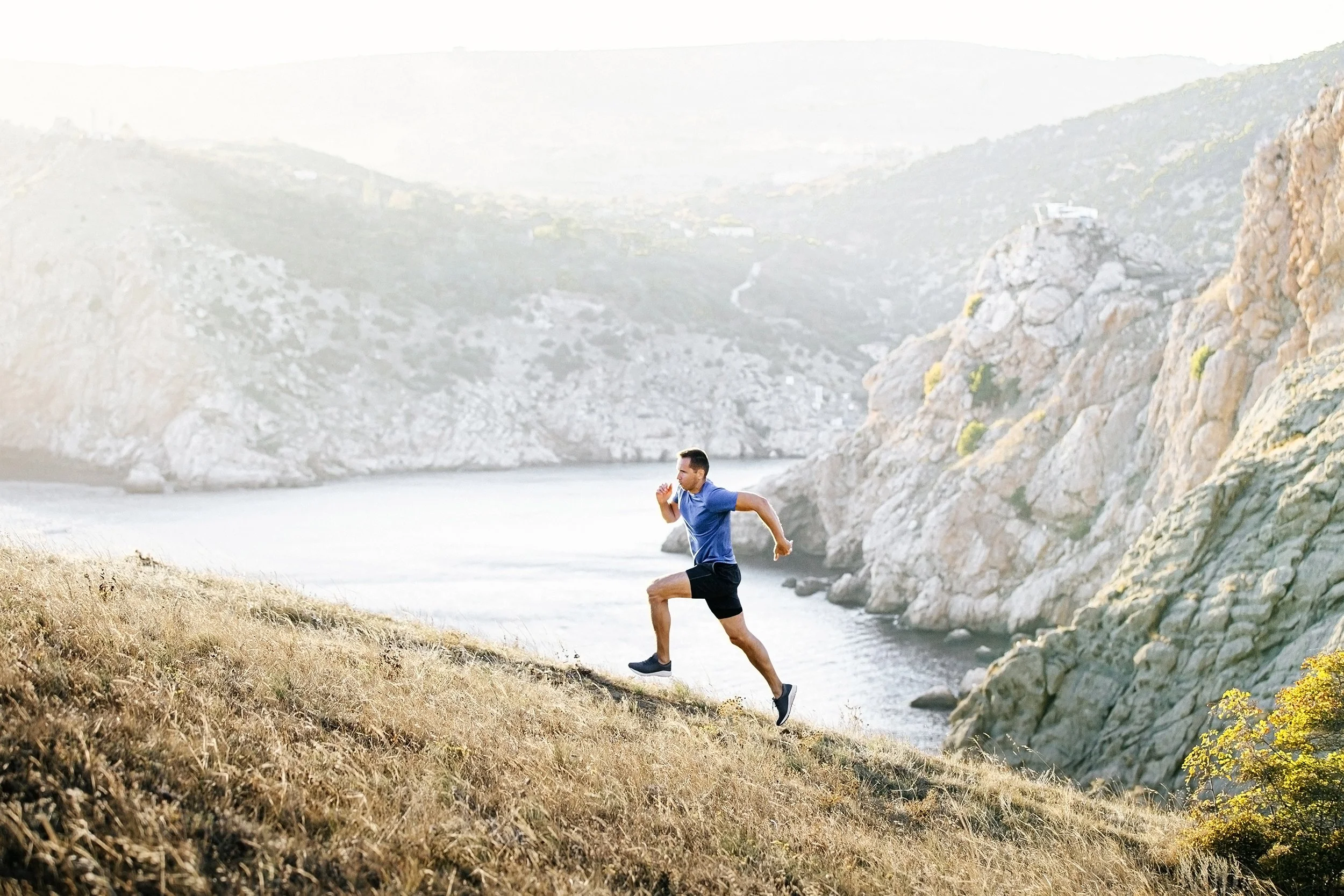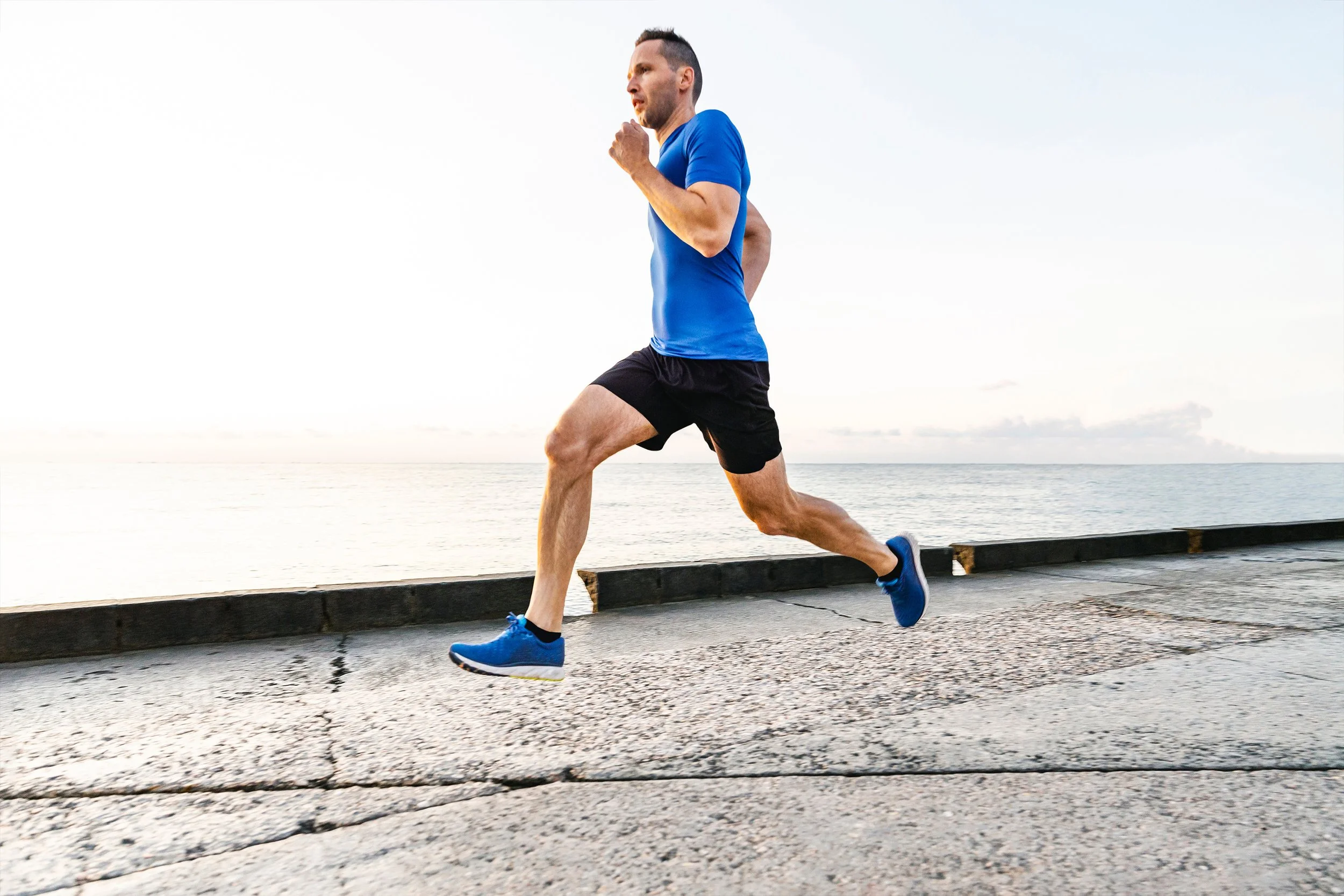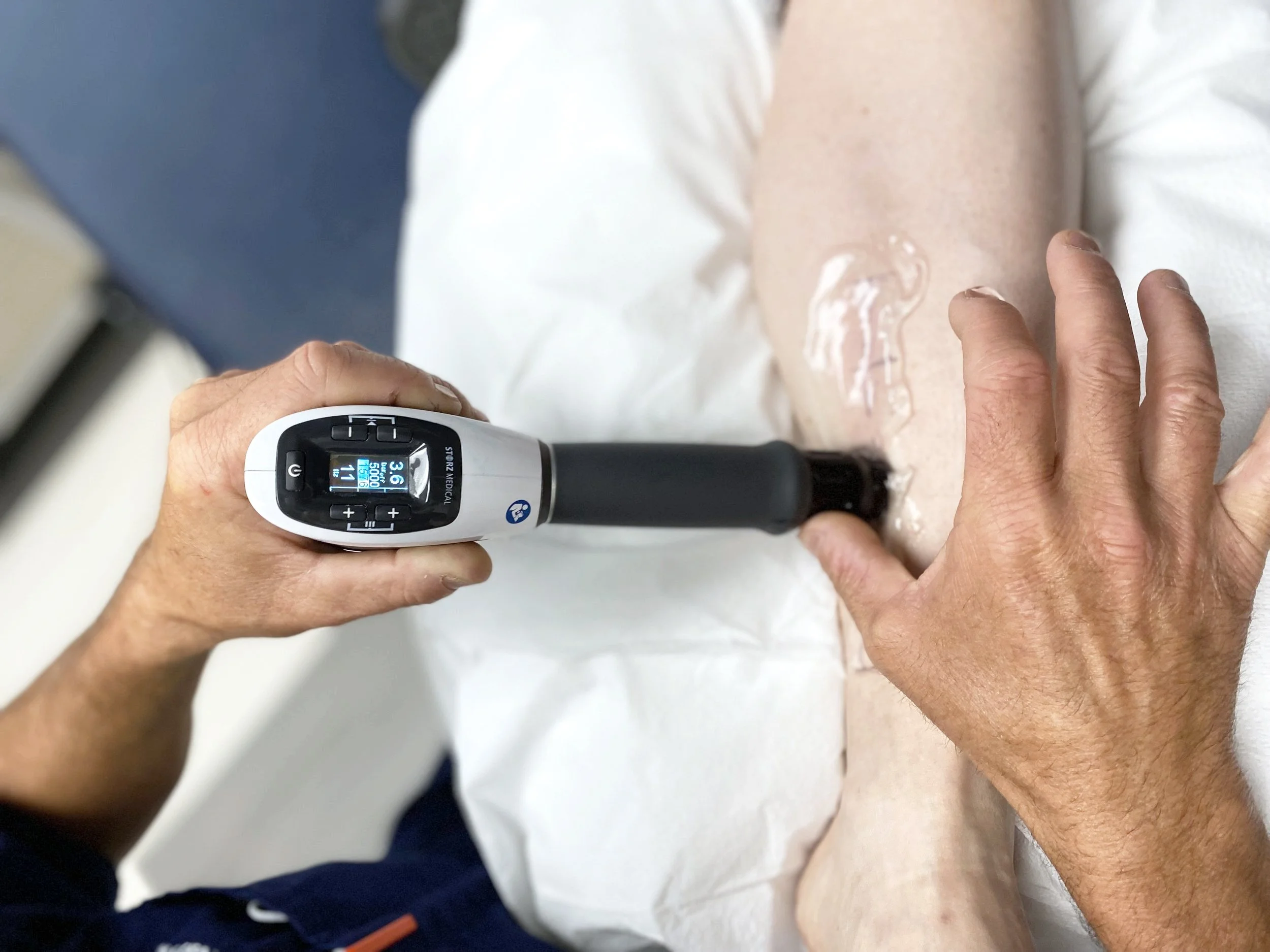Is it all about
warming up and stretching?
It is that time of year as back to school schedules allow many people to hit the pavement and trails ramping up for races or just general fitness goals. Some may have gutted out the summer heat and even smoky weather and tried to sneak in runs during breaks in the weather or indoors on the always reliable treadmill. With an increase in volume of running, we often see repetitive stress injuries that can come with inadequate attenuation of forces. If you’ve been running long enough, chances are you know someone or have a running partner who dealt with a recalcitrant tendon issue, whether involving the Achilles tendon, peroneal tendon or patellar tendon. Or maybe you had to deal with it yourself. If so, hopefully you’ve packed your patience as the process can be frustrating. If you have ever had these injuries sideline you then you know how it can hinder your ability to compete in athletic activities. It’s helpful to understand the physiology of what is happening to the tendon in order to know how best to treat it, ideally while working alongside a physical therapist familiar with running and jumping injuries.
What Does tendonitis look like for runners?
Tendonitis is an inflammatory condition of the tendon and tends to resolve in several weeks. If a tendon issue becomes chronic it is called a tendinopathy. Little inflammation is present in a tendinopathy. Instead there are pathological histologic changes in the tendon and it becomes chronic. This involves a change from normal Type I collagen fibers to Type III collagen, which can’t withstand forces like Type I fibers. In the lower extremity, we often see tendinopathies when people add volume too fast after a period of relative or total rest, run in improper footwear or exercise after weight gain or loss. The fibers experience small tears when their tensile forces are exceeded. Our goal is to load the tendons in such a way as they will repair histologically to bear load like the original Type I fibers. Tendon microtears can occur in athletes and non-athletes alike but often involve having to modify activity.
How does Physical therapy treat tendonopathies?
In physical therapy, we target tendonopathies by utilizing the principles of strength adaptations and periodization of training to set people up for the most optimal recovery. This includes the concepts of eccentric strengthening (lengthening contraction) and progressive loading. Heavy slow resistance training (HSRT), isometric strengthening and combined eccentric and concentric (shortening) contractions have all been found to be useful for tendinopathy recovery. (1) Alfredson et al is very well known for his eccentric training protocol for Achilles tendonitis in 1998. His study involved high reps (3x15, 2x/day). (2) This had been the gold standard until HSRT was presented in 2009/2010, most notably by Kongsgaard et al. With HSRT, the tendon will be subjected to higher volumes of load with greater time under tension (TOT) with fewer overall reps. The concept was to base the load on 1 RM (1 repetition max) and use higher loads (70-85% 1 RM 3x/week) while including the concentric and eccentric phases (shortening and lengthening contractions). Both methods are effective but patient compliance is higher with HSRT as patients tend to feel like they are exercising more to fatigue. (3) Isometric strengthening (muscle contraction without change in joint angle) has also been shown to give people relief but it is believed that this is due to an analgesic effect. If isometric contractions are used, the protocol tends to be 4-60 second holds for 4-5 sessions per day. (4) Any way you look at it, tendons tend to reorganize their injured fibrils (chains of myofibrils make up muscle fibers) better with loading than with stretching (3).
What about injuries that do not respond well to traditional therapy?
Unfortunately, not all injuries respond well to activity modification and dedicated exercise prescription. Any strengthening program should be given at least 12 weeks to see changes. (1) If people continue to have symptoms, they may start seeking out other procedures and techniques.
We get many questions about PRP (platelet-rich plasma) injections, ultrasound-guided percutaneous tendon scraping (5) and extracorporeal shock wave therapy (ESWT). For the purposes of this article, we will focus on the least invasive of these, ESWT. For those cases that haven’t responded as expected, there is moderate evidence that combining extracorporeal shock wave therapy (ESWT) with eccentric strengthening of the tissues for Achilles tendonitis may produce superior outcomes to eccentric loading alone (6).
Extracorporeal shock wave therapy is a noninvasive and conservative treatment largely used for Achilles tendinopathy, medial tibial stress syndrome (shin splints) and plantar fasciitis in the lower extremity and lateral epicondylitis (tennis elbow) in the upper extremity. It utilizes the delivery of shock waves through a handheld probe targeted at injured soft tissue.
““Extracorpreal Shock Wave therapy can be a great adjunct to physical therapy and a boost to your recovery.””
What does the latest research say about Shock wave?
Currently, the Mayo clinic has been using ESWT for patients whose symptoms do not improve with activity modification, rest, ice, orthotics and taping. Mayo sports medicine specialists have found this therapy beneficial for treating the following areas of tendinopathy (7):Rotator cuffLateral epicondyleMedial epicondyleGreater trochanter (gluteus medius and minimus)Proximal hamstring originRectus femorisDistal quadricepPatellar tendonPosterior tibialPeronealAchillesPlantar fasciaRandomized controlled trials (RCTs) are showing mainly beneficial effects for Achilles tendinopathy (8).
This meta-analysis reviewed 22 studies particularly targeting the Achilles tendon. Setuh et al (9) found accumulating evidence for the effectiveness of ESWT when treating lower limb tendinopathies including greater trochanteric pain, patellar tendinopathy and Achilles tendinopathy. A December 2019 prospective study, indicated the combination of eccentric strengthening and ESWT had promising results (5).
Typically, treatment is suggested to be 1x/week for 3-6 weeks. Sessions should be done one week apart. Improvement should be noted after 2 sessions but the more chronic cases can take longer to respond. Some people note immediate improvement whereas others report positive outcomes after 3-5 months.
Who Does Shock Wave Therapy Locally?
Dr. Peter Vincent and Dr. Larry Maurer at Washington Foot and Ankle are both fantastic local resources for ESWT. Washington Foot & Ankle Sports Medicine: Podiatry: Kirkland, WA (rundoctor.com) They will first evaluate someone’s candidacy for ESWT. This includes a thorough exam for differential diagnosis to rule out peripheral vascular disease, compartment syndrome, nerve entrapment or stress fracture. ESWT should be done in conjunction with a physical therapy program led by a PT familiar with the demands of your sport. With ESWT, athletes can continue to participate in their sport if pain is minimal. As a whole, tendinopathy is the most common injury in sports. (10) As biomechanical specialists, physical therapists are trained to look up and down the kinetic chain to ensure dynamic strength allows for control of aberrant movements. People can do what feels like the right thing, eating right, minimizing inflammation in the diet, dialing in their performance principles and using trained professionals to guide their workouts.
Mandie Majerus, PT receives Shock Wave therapy from Dr. Peter Vincent in Kirkland.
However, sometimes life still gets in the way and we end up training in spurts and starts trying to string a bunch of workouts together to make up for missed workouts. This can lead to inadequate adaptation to load and overload of tissues. In addition, as we age, tendons tend to lose water content. (11) This tends to make tendons more stiff and less resistant to stress. A materials scientist learns a lot about the stress and strain curve and what properties of a material indicate where elastic and plastic deformation occurs.
From a biological perspective, physical therapists and physicians use these same principles to guide our research into best protocols using engineering and physics. Our tendons store elastic energy to then release it to make a muscle engage (propel us forward in the case of the Achilles tendon with runners). Therefore, it is important to train the tendons in a manner that loads them sufficiently. In the case of a tendinopathy, this needs to be done consistently and over time (back to packing your patience). Just like you can’t floss now and then and have the same benefit of flossing several times per week, these training protocols require a regimen be followed as prescribed. So if you have a long-standing tendon issue (but feel like your training has been haphazard in trying to overcome it) consider a trial of physical therapy utilizing research-based training principles. If symptoms persist, there are other treatment options such as ESWT. Sometimes it can be a process of peeling back the onion and addressing other strength imbalances before tackling the offended tendon. I try to take this holistic approach with videotaping of patients on the treadmill while monitoring cadence, hip and core stability and shoe choice. As frustrating as a tendinopathy can be when it derails your plans, try to focus on your goals not the obstacles. Or as John Lennon said so eloquently in Watching the Wheels, “there is no problem, only solutions”.
AUTHOR:
Mandie Majerus, PT, MSPT, OCS, CSCS, SFMAc, CMPT, CFSC
CONTRIBUTORS:
Dr. Peter Vincent, DPM
Podiatrist, Runner, Skier, Performs Shock Wave
Dr. Larry Maurer, DPM
Podiatrist, Runner, Skier, Performs Shock Wave
Dr. Ghilslaine Robert, MD
Sports Medicine Physician, Performs Shock Wave
Dr. Jamie Antoine, MD
Orthopedic Surgeon ProOrtho
Dr. Troy Henning, DO
Swedish Sport & Spine, Performs Shock Wave
Ben Wobker, PT, MSPT, CSCS, CFSC, SFMAc
About the author:
Mandie is a physical therapist at Lake Washington PT in Kirkland, WA. She is a co-founder of the Alpine Training Project as well as an avid backcountry skier and ski mountaineer. She grew up skiing in Bozeman, Montana and now enjoys every opportunity to ski in the N. Cascades of Washington State and the volcanoes of the west coast. Mandie works in the medical pool with the US Ski Team including covering World Cup races and camps as the on-site PT. She particularly enjoys helping people reach their goals whether they involve the outdoors or not.
MORE BLOGS
MORE WEBINARS
references
JOSPT Nov 2013 Effectiveness of the Aldredson Protocol Compared with Lower Repetition Volume Protocol for Midportion Achilles Tendinopathy, Stevens and Tan
Diagnose & Treat, Musculoskeletal injuries, Overuse injuries Tracy Ward Tendinopathy: new thinking on an old problem (sportsinjurybulletin.com)
Br J Sports Med. 2014; 48: 506-509
Shockwave Therapy Associated With Eccentric Strengthening for Achilles Insertional Tendinopathy: A Prospective Study, 2019 Dec;12(6):540-545.doi: 10.1177/1938640019826673. Epub 2019 Feb 2. Foot Ankle Spec
Mayo Clinic 2019
BioMed Res Int, Stania et al, 2019 The effectiveness of extracorporeal shock wave therapy in lower limb tendinopathy: a systematic review - PubMed (nih.gov)
Setuh et al 2014 The effectiveness of extracorporeal shock wave therapy in lower limb tendinopathy: a systematic review - PubMed (nih.gov)
Phys Ther in Sport. 2012 June; 13:3-10
Effects of Aging - OrthoInfo - AAOS https://orthoinfo.aaos.org/en/staying-healthy/effects-of-aging













